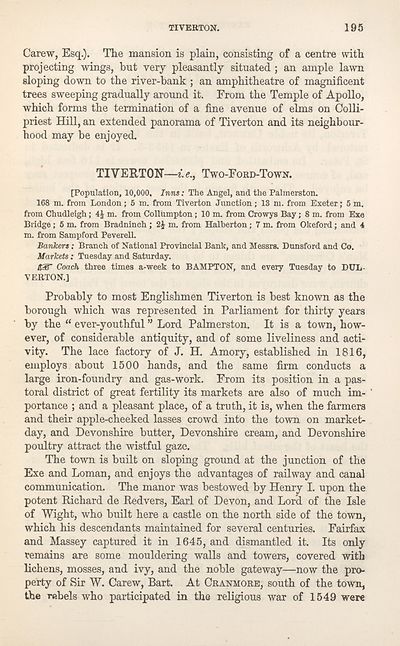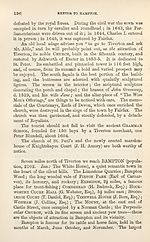Download files
Complete book:
Individual page:
Thumbnail gallery: Grid view | List view

TIVERTON.
195
Carew, Esq.). The mansion is plain, consisting of a centre with
projecting wings, hut very pleasantly situated; an ample lawn
sloping down to the river-hank ; an amphitheatre of magnificent
trees sweeping gradually around it. From the Temple of Apollo,
which forms the termination of a fine avenue of elms on Colli-
priest Hill, an extended panorama of Tiverton and its neighbour¬
hood may he enjoyed.
TIVERTON—i.e., Two-Ford-Town.
[Population, 10,000, Inns: The Augel, and the Palmerston.
168 m. from London; 5 m. from Tiverton Junction; 13 m. from Exeter; 5 m.
from Chudleigh; 4J m. from Collumpton; 10 m. from Crowys Bay; 8 m. from Exe
Bridge; 5 m. from Bradninch ; 2J m. from Halherton; 7 m. from Okeford; and 4
m. from Sampford Peverell.
Bankers: Branch of National Provincial Bank, and Messrs. Dunsford and Co.
Markets: Tuesday and Saturday.
/t3T Coach three times a-week to BAMPTON, and every Tuesday to DUL-
VERTON.]
Probably to most Englishmen Tiverton is best known as the
borough which was represented in Parliament for thirty years
by the “ ever-youthful ” Lord Palmerston. It is a town, how¬
ever, of considerable antiquity, and of some liveliness and acti¬
vity. The lace factory of J. H. Amory, established in 1816,
employs about 1500 hands, and the same firm conducts a
large iron-foundry and gas-work. From its position in a pas¬
toral district of great fertility its markets are also of much im¬
portance ; and a pleasant place, of a truth, it is, when the farmers
and their apple-cheeked lasses crowd into the town on market-
day, and Devonshire butter, Devonshire cream, and Devonshire
poultry attract the wistful gaze.
The town is built on sloping ground at the junction of the
Exe and Loman, and enjoys the advantages of railway and canal
communication. The manor was bestowed by Henry I. upon the
potent Richard de Redvers, Earl of Devon, and Lord of the Isle
of Wight, who built here a castle on the north side of the town,
which his descendants maintained for several centuries. Fairfax
and Massey captured it in 1645, and dismantled it. Its only
remains are some mouldering walls and towers, covered with
lichens, mosses, and ivy, and the noble gateway—now the pro¬
perty of Sir W. Carew, Bart. At Cranmore, south of the town,
the rebels who participated in the religious war of 1549 were
195
Carew, Esq.). The mansion is plain, consisting of a centre with
projecting wings, hut very pleasantly situated; an ample lawn
sloping down to the river-hank ; an amphitheatre of magnificent
trees sweeping gradually around it. From the Temple of Apollo,
which forms the termination of a fine avenue of elms on Colli-
priest Hill, an extended panorama of Tiverton and its neighbour¬
hood may he enjoyed.
TIVERTON—i.e., Two-Ford-Town.
[Population, 10,000, Inns: The Augel, and the Palmerston.
168 m. from London; 5 m. from Tiverton Junction; 13 m. from Exeter; 5 m.
from Chudleigh; 4J m. from Collumpton; 10 m. from Crowys Bay; 8 m. from Exe
Bridge; 5 m. from Bradninch ; 2J m. from Halherton; 7 m. from Okeford; and 4
m. from Sampford Peverell.
Bankers: Branch of National Provincial Bank, and Messrs. Dunsford and Co.
Markets: Tuesday and Saturday.
/t3T Coach three times a-week to BAMPTON, and every Tuesday to DUL-
VERTON.]
Probably to most Englishmen Tiverton is best known as the
borough which was represented in Parliament for thirty years
by the “ ever-youthful ” Lord Palmerston. It is a town, how¬
ever, of considerable antiquity, and of some liveliness and acti¬
vity. The lace factory of J. H. Amory, established in 1816,
employs about 1500 hands, and the same firm conducts a
large iron-foundry and gas-work. From its position in a pas¬
toral district of great fertility its markets are also of much im¬
portance ; and a pleasant place, of a truth, it is, when the farmers
and their apple-cheeked lasses crowd into the town on market-
day, and Devonshire butter, Devonshire cream, and Devonshire
poultry attract the wistful gaze.
The town is built on sloping ground at the junction of the
Exe and Loman, and enjoys the advantages of railway and canal
communication. The manor was bestowed by Henry I. upon the
potent Richard de Redvers, Earl of Devon, and Lord of the Isle
of Wight, who built here a castle on the north side of the town,
which his descendants maintained for several centuries. Fairfax
and Massey captured it in 1645, and dismantled it. Its only
remains are some mouldering walls and towers, covered with
lichens, mosses, and ivy, and the noble gateway—now the pro¬
perty of Sir W. Carew, Bart. At Cranmore, south of the town,
the rebels who participated in the religious war of 1549 were
Set display mode to:
![]() Universal Viewer |
Universal Viewer | ![]() Mirador |
Large image | Transcription
Mirador |
Large image | Transcription
| Antiquarian books of Scotland > Adventure and adventurers > Black's guide to the counties of Dorset, Devon, & Cornwall > (234) |
|---|
| Permanent URL | https://digital.nls.uk/142589187 |
|---|
| Description | Thousands of printed books from the Antiquarian Books of Scotland collection which dates from 1641 to the 1980s. The collection consists of 14,800 books which were published in Scotland or have a Scottish connection, e.g. through the author, printer or owner. Subjects covered include sport, education, diseases, adventure, occupations, Jacobites, politics and religion. Among the 29 languages represented are English, Gaelic, Italian, French, Russian and Swedish. |
|---|

